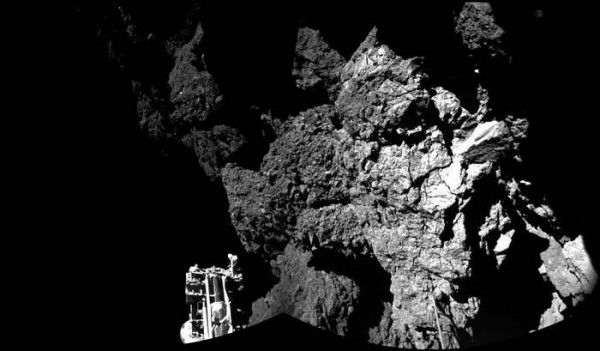Philae Falls Silent as Batteries Die; Initial Phase of Comet Mission Completed
| Ana Verayo | | Nov 16, 2014 04:45 AM EST |
(Photo : ESA/Rosetta/Philae/CIVA) Rosetta’s lander, Philae, is safely on the surface of Comet 67P/Churyumov-Gerasimenko.
After its historic landing on Comet 67P/Churyumov-Gerasimenko last Nov. 12, the Philae robotic lander managed to send readings and scientific data back to Earth despite problems with its power supply. Controllers said this will be the last transmission since Philae's failing batteries automatically placed it on standby mode to save power.
Like Us on Facebook
As Philae landed on the surface of the comet, it bounced twice before finally coming to rest behind a cliff. Unfortunately, this cliff is casting a deep shadow that's preventing Philae from recharging its batteries via its solar panels.
Philae's landing site allows the lander to receive only 1.5 hours of direct sunlight during that 12 hour window when the comet rotates and faces the sun. Unfortunately, this short time span isn't enough to power Philae's batteries.
Comet 67P rotates every 12 hours. This is considered as a full day on the comet.
This accident might be a major setback for the mission but ESA scientists said they received essential research data from the probe before it became inactive.
The Rosetta team said Philae is in an idle mode that will keep it silent for some time. This mode shuts down of most of Philae's systems and the entire suite of onboard instruments.
Before this shutdown, Philae successfully drilled into the comet to take dust samples analyzed by its 10 onboard instruments. Philae then transmitted the data from these experiments back to Earth.
Rosetta project manager Stephan Ulamec said before the lander went silent, it sent important scientific data from the First Science Sequence. The space lab performed remarkably well under these grueling conditions and Philae's precious data is considered an incredible scientific success.
Even if Philae's in a most disadvantageous location where it can't receive the solar energy it needs, it managed to obtain soil samples for analysis, which is its primary mission.
There's a glimmer of hope that this situation might change for the better. Mark McCaughrean, ESA senior scientific adviser believes that as comet 67P moves closer to the sun, Philae will get more light on its solar panels despite its position under a cliff.
Comet 67P's approach towards the sun drastically changes the timing, intensity and angle of sunlight that will hit the lander's solar panels. The closest approach could occur on August 13, 2015.
TagsPhilae Lander Falls Silent as Batteries Die; Initial Phase of Comet Mission Completed, ESA, rosetta probe, philae lander, comet 67P, philae batteries dies completes mission
©2015 Chinatopix All rights reserved. Do not reproduce without permission
EDITOR'S PICKS
-

Did the Trump administration just announce plans for a trade war with ‘hostile’ China and Russia?
-

US Senate passes Taiwan travel bill slammed by China
-

As Yan Sihong’s family grieves, here are other Chinese students who went missing abroad. Some have never been found
-

Beijing blasts Western critics who ‘smear China’ with the term sharp power
-

China Envoy Seeks to Defuse Tensions With U.S. as a Trade War Brews
-

Singapore's Deputy PM Provides Bitcoin Vote of Confidence Amid China's Blanket Bans
-

China warns investors over risks in overseas virtual currency trading
-

Chinese government most trustworthy: survey
-

Kashima Antlers On Course For Back-To-Back Titles
MOST POPULAR
LATEST NEWS
Zhou Yongkang: China's Former Security Chief Sentenced to Life in Prison

China's former Chief of the Ministry of Public Security, Zhou Yongkang, has been given a life sentence after he was found guilty of abusing his office, bribery and deliberately ... Full Article
TRENDING STORY

China Pork Prices Expected to Stabilize As The Supplies Recover

Elephone P9000 Smartphone is now on Sale on Amazon India

There's a Big Chance Cliffhangers Won't Still Be Resolved When Grey's Anatomy Season 13 Returns

Supreme Court Ruled on Samsung vs Apple Dispute for Patent Infringement

Microsoft Surface Pro 5 Rumors and Release Date: What is the Latest?










